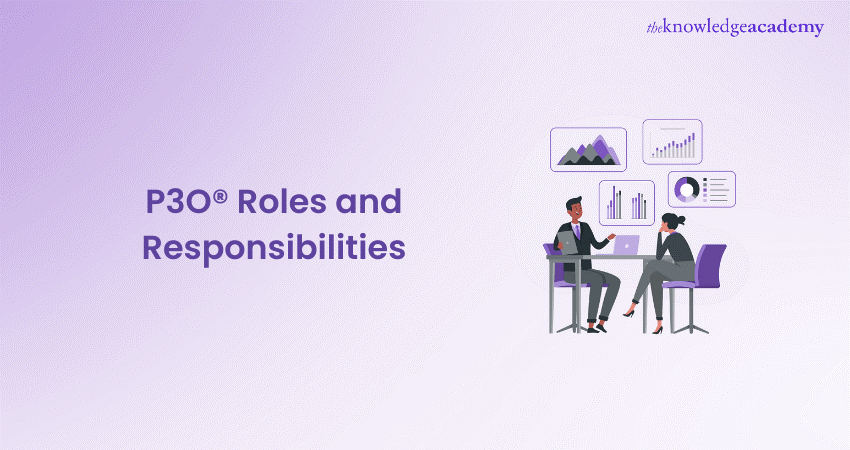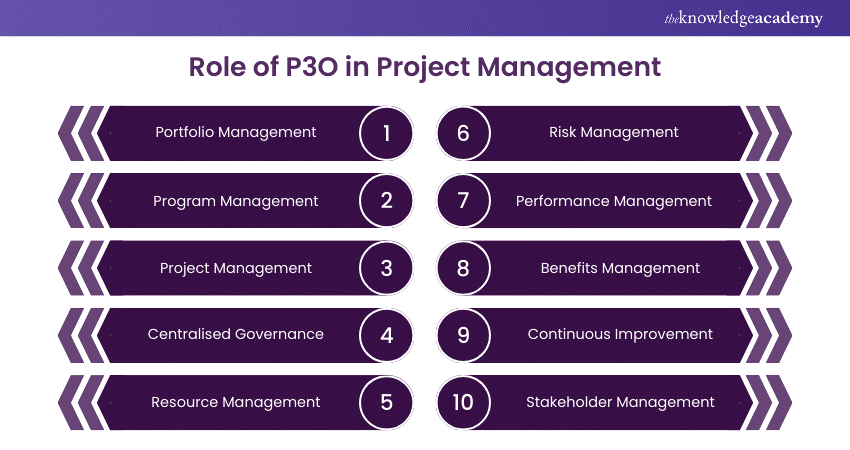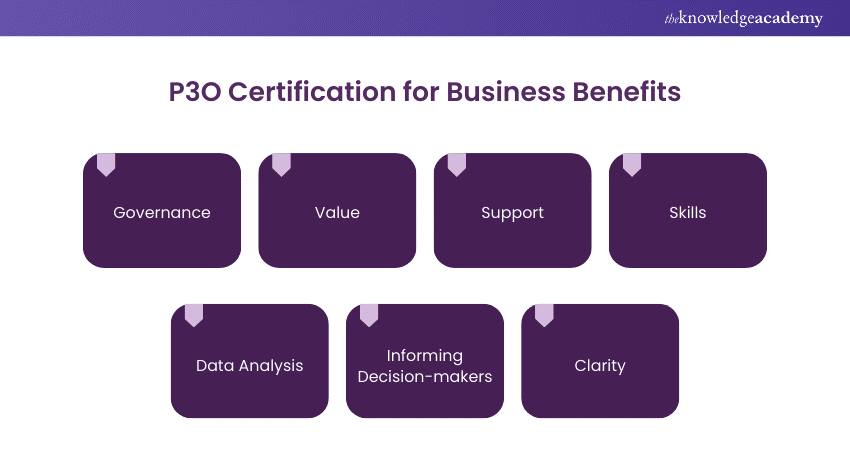We may not have the course you’re looking for. If you enquire or give us a call on +61 272026926 and speak to our training experts, we may still be able to help with your training requirements.
We ensure quality, budget-alignment, and timely delivery by our expert instructors.

Are you familiar with P3O® Roles and Responsibilities and how they influence project outcomes? Understanding these key elements can streamline decision-making and enhance project governance. In this blog, we will take a closer look at the importance of P3O® roles and responsibilities and their impact on organisational Project Management. Learn how to implement them effectively to drive success and optimise your Project Management strategy today.
Table of Contents
1) What are P3O®s?
2) How does P3O® work?
3) P3O® Model Role in Project Management
4) P3O® Certification for Business Benefits
5) P3O® Job Roles
6) Conclusion
What are P3O®s?
Achieving strategic growth in business involves effectively managing projects and programs within a portfolio, where stakeholder decisions, risks, and expenditures play critical roles in driving progress or setbacks. Given this complexity, successful businesses prioritise reliable support frameworks like P3O—Portfolio, Programme, and Projects Offices.
P3O serves as a decision-enabling model aimed at optimising change delivery for maximum efficiency and ROI. Each P3O office is tailored to the organisation's goals, market, capabilities, and structure. This ensures seamless integration with ongoing operations while minimising disruption caused by strategic changes.
Still curious about P3O and how does it work? Continue reading this blog to understand about it in detail.
How does P3O® work?
P3O operates by providing actionable insights, practices, and guidance to establish, manage, and sustain support structures. These structures help decision-makers in effectively managing portfolios, programs, and projects.
P3O offers:
1) Descriptions of portfolio office constituents, techniques, and functions
2) Insights into various P3O models
3) Advice on optimising P3O guidance
4) Practices to enhance outcomes in portfolio, program, and project environments
For example, P3O defines:
1) Project: A temporary organisation delivering business products aligned with the approved business case.
2) Program: A flexible organisation overseeing project implementation to achieve strategic objectives.
3) Portfolio: The organisation’s total investment in change and strategic pursuits.
P3O centralises decision-making support, providing a comprehensive view of portfolio progress, risks, conflicts, and benefits. It facilitates informed decision-making without making decisions itself. This ensures stakeholders have necessary information through portfolio documents and progress updates.
Furthermore, P3O is designed to integrate smoothly with existing processes in areas such as finance and HR, as well as management frameworks like Managing Successful Programmes (MSP), PRINCE2, and Management of Risk (MoR). This adaptability makes P3O suitable for organisations of any size and structure.
Ultimately, a P3O office empowers organisations to address key questions about project and program efficiency, business value, financial viability, quality consistency, and standardised management practices. It functions as a centralised support hub, equipping organisations with essential tools and guidance for effective change-facilitation.
Do you want to build a strong foundation for project success? Register with our P3O® Foundation Course today!
P3O® Model Role in Project Management
In this section, we will look at how P3O helps in effective Project Management. We will also talk about Centralised Governance, Resource Management, Performance Management, Risk Management, Benefits Management, and Stakeholder Management. Additionally, we will discuss how the P3O model focuses on continuous improvement.

1) Portfolio Management
The Portfolio Management in the P3O model oversee the organisation’s project portfolio. This involves identifying, prioritising, and selecting projects that align with the organisation’s strategic objectives. The Portfolio Management function ensures optimal allocation of resources to the most critical projects, thereby maximising the organisation’s value.
2) Program Management
Program Management focuses on overseeing individual projects, ensuring their successful planning, execution, and control. This involves setting clear objectives, defining the scope, and establishing timelines. The Program Management function aims to achieve specific project goals by coordinating resources, managing budgets, and monitoring progress.
3) Project Management
The Project Management function in the P3O model focuses on managing individual projects. This includes the planning, execution, and control of projects to achieve their specific objectives. The Project Management function ensures that projects are completed within the allocated time frame, budget, and resources.
4) Centralised Governance
The P3O model provides centralised governance to ensure that projects, programs, and portfolios match the organisation’s strategic goals. This governance structure offers oversight, guidance, and support to project, program, and portfolio managers, ensuring they have the necessary resources and backing to deliver projects successfully.
5) Resource Management
The P3O model offers a framework for resource management across projects, programs, and portfolios. It involves allocating resources based on project priority and availability, ensuring their effective and efficient utilisation. This approach maximises the value delivered to the organisation.
6) Risk Management
The P3O model employs a structured approach to risk management, which includes identifying, assessing, and managing risks across projects, programs, and portfolios. This approach ensures that risks are identified early and managed effectively, minimising their impact.
7) Performance Management
The P3O model includes a framework for measuring and managing performance at the project, program, and portfolio levels. Performance management involves collecting, analysing, and reporting data to monitor and manage performance, ensuring the successful delivery of projects, programs, and portfolios.
8) Benefits Management
The P3O model offers a framework for managing benefits across projects, programs, and portfolios. Benefits management involves identifying, planning, and realising benefits, ensuring they are effectively managed to maximise organisational value.
9) Continuous Improvement
The P3O model promotes continuous improvement by identifying opportunities to enhance project, program, and Portfolio Management practices. It ensures that lessons learned are captured and shared, improving overall organisational performance.
10) Stakeholder Management
The P3O model adopts a structured approach to stakeholder management, which involves identifying and managing stakeholders across projects, programs, and portfolios. Effective stakeholder management ensures that stakeholder expectations are met, and their feedback is incorporated into the organisation’s Project Management processes.
Want to secure the job? Practice answering office manager interview questions and showcase your organizational skills and leadership potential!
P3O® Certification for Business Benefits
A P3O office offers several benefits to a business:

1) Governance
A key responsibility of a P3O Practitioner is to help stakeholders understand the alignment of projects, programs, and decisions with the organisation’s overall strategy. This ongoing analysis helps in quickly escalating potential issues, allowing for timely corrective actions.
2) Value
As the P3O monitors project and program progress, it also evaluates the benefits and value generated. This prevents resource wastage and maximises the Return on Investment (ROI) of strategic changes. Additionally, it helps practitioners identify potential improvements that align with the organisation’s strategic value.
3) Support
P3O Practitioners, though not managers themselves, ensure that program and project managers receive the necessary support to achieve their targets. They analyse progress, considering factors like cost-effectiveness and skill requirements, making it easier for managers to meet their goals.
4) Skills
The P3O framework is versatile and can be applied to any organisation. Practitioners who are familiar with their business can easily integrate existing elements into a new portfolio office. This also provides a career path for project and program managers, increasing their investment in the company and reducing turnover.
5) Data Analysis
P3O Practitioners focus on examining, interpreting, and communicating data to aid senior management in decision-making. This analytical approach is important for achieving long-term strategic growth rather than merely optimising individual project results.
6) Informing Decision-makers
While P3O Practitioners do not make decisions themselves, they provide the necessary information and perspective for stakeholders to do so. They ensure the quality of information by following best practices for capturing, processing, storing, archiving, and presenting data.
7) Clarity
A P3O clarifies the roles and responsibilities required to facilitate projects and programs. This clarity empowers employees and teams by helping them understand their contribution to the organisation’s strategy. The P3O framework itself outlines 21 management, generic, and functional roles within a P3O office.
Enhance your Project Management skills with our P3O® Practitioner Training - Sign up right now!
P3O® Job Roles
There are three primary job roles within a Portfolio, Programme, and Project Office (P3O), also known as a Project Management Office (PMO):
1) Project Management Office Coordinator
Project Management Office Coordinators are crucial in various sectors and industries. A coordinator organises and supports programs and individual projects to ensure a productive working environment. Their tasks include maintaining project documentation, conducting project forecasts, analysing progress, keeping issue logs, and coordinating meetings.
In essence, the P3O® Coordinator ensures the utilisation of best-practice methods within projects to enhance their business value and continuity from start to finish. Obtaining the Registered P3O® Practitioner status equips individuals to fulfil the Project Management Office Coordinator role with professional excellence.
2) Portfolio, Programme, and Project Office Analyst
The role of a Portfolio Office Analyst is multifaceted, combining Project Management techniques with administration and statistical analysis. A P3O® Analyst ensures a consistent standard of best practice that enhances business value. They analyse projects to determine optimal functionality, recommend changes, or advise on project termination, providing results to the P3O® Manager. Understanding How to Add P3O to Your CV can be valuable for professionals looking to highlight their expertise in portfolio management.
Analysts need a comprehensive and holistic view of a portfolio to maximise the value and impact of their analysis-based decisions. Advanced statistical knowledge is essential for monitoring the progress of multiple simultaneous projects.
3) P3O® Office Manager
The Project Office Manager leads the P3O®, making critical decisions about project continuation or closure. This role is key in driving strategic excellence, involving pivotal decisions regarding budget, resources, and project scope. The manager outlines Project Management standards within a business and coordinates specialist tasks, holding the highest position in a P3O®.
A PMO/P3O® Manager tailors and utilises various standardised methodologies, including P3O®, PRINCE2®, and MSP®. Extensive Project Management knowledge is required. During the development of a portfolio office, the scope of tasks and decisions may be unclear. Thus, the office manager must lead the delivery of the business’s vision and ensure operations align with predetermined objectives. Leveraging a PRINCE2 Portfolio approach can help streamline processes and enhance governance.
Understand the key functions and services of a P3O with our P3O® Foundation Exam Resit Course – Register now!
Conclusion
The P3O® model provides a structured approach to Project Management, enabling organisations to manage projects, programs, and portfolios effectively. By centralising governance, it ensures efficient management of resources, risks, performance, benefits, and stakeholders, leading to successful project outcomes. Implementing the P3O model helps organisations achieve their objectives, maximise value, and enhance overall performance. Therefore, understanding P3O roles and responsibilities is crucial to fully harnessing these benefits and optimising project delivery.
Accelerate your portfolio, programme, and Project Management career with our various P3O® Training – Join today!
Frequently Asked Questions
Does P3O® Certification Expire?

P3O certification does not expire. Once you obtain the certification, it remains valid for life. However, it's beneficial to stay updated with the latest practices and methodologies in project, program, and Portfolio Management to maintain your skills and knowledge.
What are the Capabilities of P3O®?

P3O offers several capabilities, including centralised governance, efficient resource allocation, comprehensive risk management, performance tracking, benefits management, and effective stakeholder engagement. These capabilities help organisations deliver projects successfully.
What are the Other Resources and Offers Provided by The Knowledge Academy?

The Knowledge Academy takes global learning to new heights, offering over 3,000 online courses across 490+ locations in 190+ countries. This expansive reach ensures accessibility and convenience for learners worldwide.
Alongside our diverse Online Course Catalogue, encompassing 19 major categories, we go the extra mile by providing a plethora of free educational Online Resources like News updates, Blogs, videos, webinars, and interview questions. Tailoring learning experiences further, professionals can maximise value with customisable Course Bundles of TKA.
What is The Knowledge Pass, and How Does it Work?

The Knowledge Academy’s Knowledge Pass, a prepaid voucher, adds another layer of flexibility, allowing course bookings over a 12-month period. Join us on a journey where education knows no bounds.
What are the Related Courses and Blogs Provided by The Knowledge Academy?

The Knowledge Academy offers various P3O Training, including P3O® Foundation, P3O® Practitioner and P3O® Foundation Exam Resit. These courses cater to different skill levels, providing comprehensive insights into Main Functions and Services of a P3O
Our Project Management Blogs cover a range of topics related to P3O, offering valuable resources, best practices, and industry insights. Whether you are a beginner or looking to advance your Project Management skills, The Knowledge Academy's diverse courses and informative blogs have got you covered.
Upcoming Project Management Resources Batches & Dates
Date
 P3O® Foundation
P3O® Foundation






 Top Rated Course
Top Rated Course



 If you wish to make any changes to your course, please
If you wish to make any changes to your course, please


